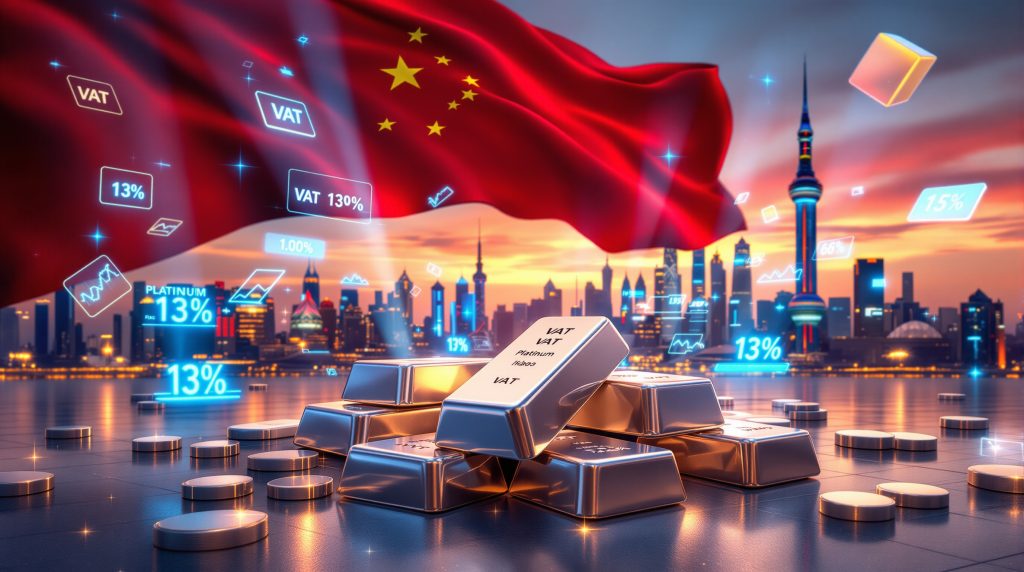Understanding China's Groundbreaking Platinum VAT Reform
China's decision to eliminate its two-decade-old platinum import tax exemption marks a pivotal transformation in global precious metals markets. The China platinum VAT reform represents far more than a simple policy adjustment, fundamentally reshaping how the world's second-largest economy approaches precious metals trade. Beginning November 1, 2025, the Chinese government will impose a uniform 13% value-added tax on all platinum imports, dismantling the exclusive privilege previously enjoyed by the state-controlled China Platinum Company (CPC) since 2003.
This policy shift creates ripple effects that extend from Shanghai trading floors to South African mining operations. Market participants are already witnessing unprecedented volatility as traders scramble to position themselves ahead of the implementation deadline, demonstrating the reform's far-reaching implications.
The timing of this announcement has caught many industry observers by surprise, particularly given China's historical preference for gradual market liberalisation. However, precious metals experts suggest this accelerated timeline reflects Beijing's growing confidence in market-based mechanisms and its desire to enhance price transparency in strategic commodity markets.
The End of China's Two-Tier Platinum System
For over twenty years, China operated under a complex dual-pricing mechanism that created significant market distortions. The China Platinum Company maintained exclusive access to tax-free imports, whilst all other market participants faced the full 13% VAT burden. This arrangement effectively created two separate platinum markets within a single country.
Under the previous system, CPC-imported platinum could be channelled through the Shanghai Gold Exchange as VAT-refundable metal. This created substantial cost advantages for state-approved entities, whilst private companies and industrial users requiring platinum for manufacturing processes faced significantly higher acquisition costs. Such challenges parallel those seen with Ukrainian VAT refunds, highlighting the complexity of tax policy in commodity markets.
The elimination of this preferential treatment levels the competitive landscape, allowing international trading companies and industrial consumers to compete on equal footing. This democratisation of import privileges is expected to increase market participation substantially, with estimates suggesting trading volumes could increase by 200-300% within the first year of implementation.
Market structure experts note that similar reforms in other commodity sectors have typically resulted in improved liquidity and more efficient price discovery mechanisms. Furthermore, the platinum market's transition may follow comparable patterns, though the timeline for full benefits realisation remains uncertain.
Immediate Market Disruptions and Trading Frenzy
Shanghai Gold Exchange platinum contracts have experienced extraordinary volatility in anticipation of the November deadline. Premium spikes reached 13.7% above London prices, equivalent to approximately $216 per ounce, representing the highest premium levels recorded since early 2025.
Daily trading volumes surged to 982 kg last week, marking a four-month high as market participants rushed to complete transactions before the tax implementation. This trading frenzy reflects the urgency amongst buyers to secure inventory at current tax-advantaged rates.
Key Market Indicators During Pre-Implementation Period:
- Premium to London prices: 13.7% ($216/oz)
- Daily trading volumes: 982 kg (4-month high)
- Forward contract backwardation: Significant discounts to spot
- Liquidity conditions: Severely strained
- Price volatility: 6% daily swings observed
The Shanghai futures market has exhibited extreme backwardation, with forward contracts trading at substantial discounts to spot prices. This unusual pricing structure indicates market participants' desperation to secure immediate delivery before tax obligations increase their cost basis.
Precious metals analysts describe the current market conditions as reminiscent of supply disruption scenarios. However, in this case, the disruption stems from regulatory rather than physical constraints, creating artificial scarcity through the impending tax change that has fundamentally altered normal supply-demand dynamics.
Global Pricing Implications and Supply Chain Restructuring
The reform's impact extends far beyond China's borders, with international platinum prices experiencing increased volatility as global supply chains adapt to the new reality. London-based trading desks report heightened interest from Chinese buyers seeking to establish direct procurement relationships.
Expected Timeline of Market Adjustments:
| Phase | Duration | Primary Characteristics | Price Impact |
|---|---|---|---|
| Pre-implementation | Oct-Nov 2025 | Import surge, premium spikes | High volatility (+/- 8%) |
| Initial adjustment | Dec 2025-Feb 2026 | Market restructuring | Continued volatility (+/- 6%) |
| Stabilisation | Mar-Jun 2026 | New equilibrium formation | Gradual normalisation |
| Long-term | Post-Jun 2026 | Enhanced price discovery | Reduced volatility |
South African platinum producers are reassessing their export strategies to capitalise on potential new direct relationships with Chinese industrial users. The removal of CPC's monopolistic position creates opportunities for mining companies to establish value-added partnerships with downstream manufacturers.
International shipping and logistics companies are also adapting their services to accommodate increased direct imports. Consequently, port facilities in major Chinese cities are preparing for higher platinum shipment volumes as more entities gain economically viable access to international markets.
Industrial Sector Adaptations and Cost Management
Chinese automotive manufacturers face the most immediate impact from the VAT reform, as platinum remains crucial for catalytic converter production. The 13% cost increase may accelerate research into alternative catalyst technologies or drive greater emphasis on platinum recycling initiatives.
Electronics manufacturers utilising platinum in various applications are implementing comprehensive cost management strategies. Some companies are exploring long-term supply contracts to mitigate price volatility, whilst others are investigating substitution possibilities for non-critical applications. This adaptation process reflects broader mining evolution trends in response to changing market conditions.
Industries Most Affected by VAT Reform:
- Automotive sector: Catalytic converter production
- Electronics manufacturing: Specialised components
- Chemical processing: Catalyst applications
- Jewellery production: Luxury goods manufacturing
- Medical devices: Precision instrumentation
Chemical processing facilities using platinum catalysts are particularly vulnerable to cost pressures. The reform may drive consolidation in sectors where platinum costs represent significant portions of production expenses, potentially leading to increased efficiency and innovation in catalyst recovery processes.
Some industrial users are exploring partnership arrangements with recycling companies to establish closed-loop platinum supply chains. These initiatives could partially offset the increased import costs whilst supporting China's broader circular economy objectives.
International Supplier Strategic Repositioning
Major platinum producing regions, particularly South Africa's Bushveld Complex, are experiencing increased interest from Chinese buyers seeking to establish direct supply relationships. Mining companies are investing in enhanced marketing capabilities to capitalise on the expanded Chinese market access.
Anglo American Platinum and Impala Platinum Holdings have reportedly increased their Beijing-based business development activities. These companies recognise the opportunity to diversify their customer base beyond traditional CPC relationships, establishing local representative offices and developing Mandarin-language marketing materials.
Financial institutions are developing new hedging products specifically designed for Chinese platinum consumers who previously relied on CPC's stable pricing structure. These instruments include forward contracts, options strategies, and structured products tailored to industrial users' specific risk profiles.
Strategic Adaptations by International Suppliers:
- Direct relationship development with Chinese industrial users
- Enhanced local market presence and support
- Customised financing and hedging solutions
- Improved logistics and delivery capabilities
- Technical support and application development services
The reform creates opportunities for mid-tier platinum suppliers who were previously unable to compete with CPC's tax advantages. For instance, smaller mining operations and specialised trading companies can now access Chinese markets on more equitable terms.
What Makes This Reform Different From Global Approaches?
China's move toward tax standardisation contrasts with the varied approaches maintained by other major platinum-consuming regions. The European Union's complex precious metals tax framework includes investment-grade exemptions and country-specific variations, whilst the United States maintains zero import duties on platinum.
International Platinum Import Tax Comparison:
| Region | Standard Rate | Exemptions | Market Structure |
|---|---|---|---|
| China (post-reform) | 13% VAT | None | Open competition |
| European Union | 0-25% VAT | Investment grade | Regulated markets |
| United States | 0% duty | None | Free market |
| India | 12.5% GST | Limited exemptions | Mixed system |
| Japan | 10% consumption tax | Industrial exemptions | Regulated |
India's goods and services tax approach shares similarities with China's reformed system, though India maintains certain exemptions for specific industrial applications. Japan's consumption tax structure provides some industrial exemptions, reflecting the country's significant automotive and electronics sectors.
The reform positions China amongst the more standardised tax regimes globally, potentially improving its attractiveness as a transparent trading partner. International trade organisations have noted this development as consistent with China's broader commitments to market-based economic policies.
Economic Efficiency and Market Development Benefits
Market structure economists anticipate significant efficiency improvements as the reformed system eliminates artificial price distortions that previously favoured state-controlled entities. The transition toward market-based pricing mechanisms aligns with China's broader economic liberalisation objectives.
Price transparency improvements should enhance global platinum market integration, reducing arbitrage opportunities that previously existed between Chinese and international markets. This integration may contribute to more stable long-term pricing patterns across all major platinum markets, similar to the effects observed in the critical minerals energy transition.
Expected Efficiency Improvements:
- Enhanced price discovery mechanisms
- Reduced market segmentation
- Increased competitive pressure
- Improved resource allocation
- Greater market liquidity
The reform demonstrates China's evolving approach to strategic commodity markets, moving away from state-controlled monopolies toward more competitive frameworks. This shift may influence similar reforms in other precious metals markets, including palladium and rhodium.
International trade relations may also benefit from China's demonstration of market-based policy development. However, the reform addresses long-standing concerns about preferential treatment for state-owned enterprises in strategic commodity sectors.
Strategic Recommendations for Market Participants
Trading companies should prioritise developing comprehensive China strategies that include direct relationships with industrial users, enhanced risk management capabilities, and flexible supply chain arrangements. The increased market volatility requires sophisticated hedging approaches and real-time market intelligence.
Action Items for International Traders:
- Establish Beijing and Shanghai representative offices
- Develop Mandarin-language customer support capabilities
- Implement advanced risk management systems
- Create flexible inventory management strategies
- Build relationships with Chinese logistics providers
Industrial platinum users should reassess their procurement strategies to optimise costs under the new tax regime. Furthermore, long-term supply contracts may provide price stability, whilst investment in recycling capabilities could reduce overall platinum requirements.
Financial service providers have opportunities to develop innovative products addressing the specific needs of newly empowered Chinese platinum consumers. These products should address both price volatility and currency risk management requirements.
Implementation Challenges and Regulatory Uncertainties
Several key implementation details remain unclear as the November deadline approaches. Customs procedures for the new tax regime, transition arrangements for existing contracts, and potential grandfathering provisions require clarification from Chinese regulatory authorities.
The speed of new market participant entry will significantly influence how quickly competitive benefits materialise. Regulatory approval processes for international companies seeking to establish Chinese operations may create bottlenecks during the initial transition period.
Outstanding Regulatory Questions:
- Specific customs clearance procedures
- Treatment of in-transit shipments
- Contract grandfathering provisions
- Documentation requirements
- Appeal and dispute resolution mechanisms
Market infrastructure development, including warehousing facilities and quality assurance systems, may require several months to accommodate increased direct import volumes. The Shanghai Gold Exchange is reportedly enhancing its systems to handle anticipated trading volume increases.
Banking and payment systems supporting international platinum transactions need upgrades to accommodate the expected increase in direct Chinese purchases. Consequently, foreign exchange considerations become more complex as more entities engage in international platinum procurement.
How Will Markets Respond to Long-term Changes?
Industry analysts project a 6-12 month adjustment period as market participants adapt to the competitive landscape. Long-term benefits should include improved resource allocation, reduced price volatility, and enhanced integration with global platinum markets.
The reform represents China's commitment to market-based precious metals trading, signalling potential similar changes in related commodity sectors. Success will be measured through increased market liquidity, improved price discovery, and reduced regulatory arbitrage opportunities. These developments may mirror patterns observed in gold's historic price surge and other commodity market reforms.
Projected Long-term Outcomes:
- Increased market competition and efficiency
- Enhanced price transparency and discovery
- Reduced Chinese market premiums to international prices
- Greater integration with global platinum markets
- Improved resource allocation and supply chain optimisation
The development establishes precedent for similar reforms in other strategic commodity markets. Palladium and rhodium markets may experience comparable policy changes as China continues its market liberalisation initiatives.
Moreover, technological innovations in platinum recycling and substitution may accelerate as industrial users seek to optimise costs under the new tax regime. These developments could have significant implications for global platinum demand patterns and mining industry investment strategies, particularly when considered alongside comprehensive tariff impact analysis and broader economic reforms.
Understanding the China platinum VAT reform requires careful monitoring of both immediate market disruptions and long-term structural changes that will reshape global precious metals trading for years to come.
The China Platinum Company has held exclusive import privileges since 2003, making this reform particularly significant for market structure transformation. According to industry reports, the removal of VAT exemptions on platinum imports will increase costs substantially for Chinese consumers. Additionally, Beijing's decision to scrap platinum rebates represents a fundamental shift in China's approach to precious metals taxation policy.
Disclaimer: This analysis is based on publicly available information as of October 2025. Market conditions and regulatory policies may change rapidly. Investors and market participants should conduct independent research and consult qualified professionals before making investment or business decisions related to platinum markets.
Looking for Investment Opportunities in China's Reformed Precious Metals Markets?
China's platinum VAT reform creates significant market disruption and new trading opportunities across precious metals and related mining sectors. Discovery Alert uses its proprietary Discovery IQ model to deliver real-time alerts on major ASX mineral discoveries, helping investors identify actionable opportunities as global commodity markets undergo structural changes like China's platinum tax reforms.




